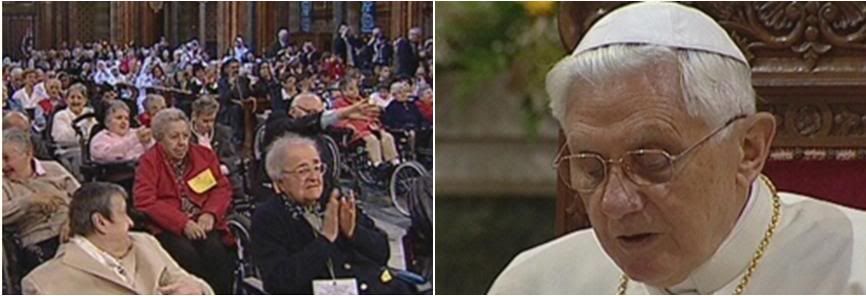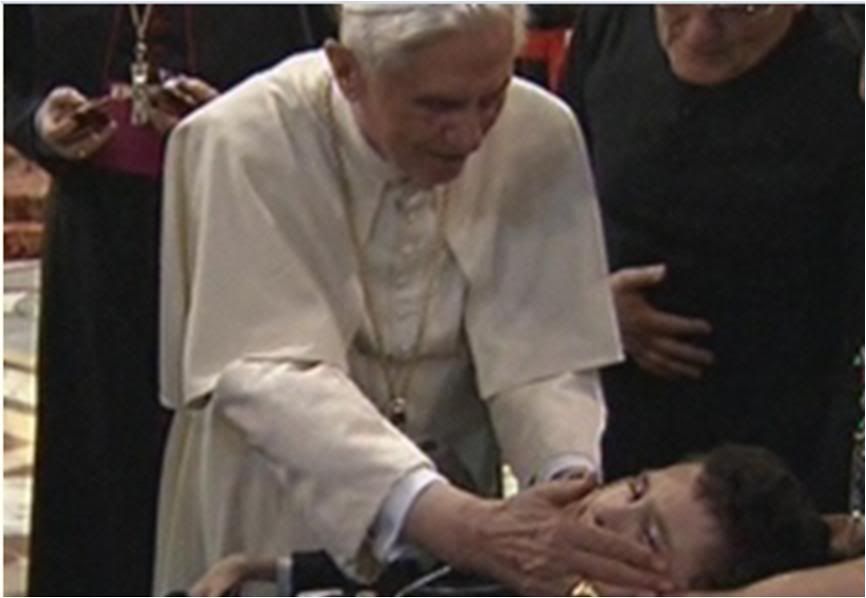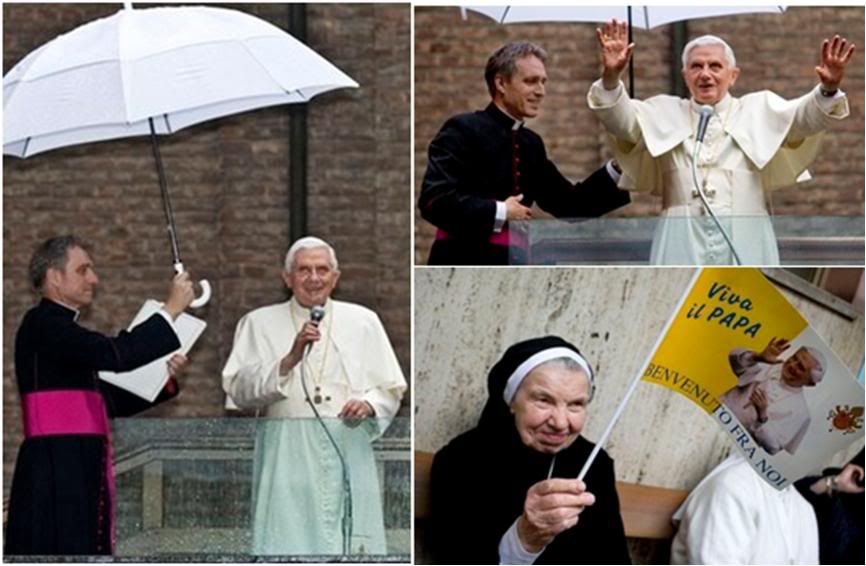 When the Holy Father devoted his catechesis last Wednesday to two of Turin's famous 19th-century 'social saints', it was certainly extraordinary that one of them is named 'Giuseppe Benedetto' - just as it is extraordinary that the saint whose feast day was April 16 (until it as moved up to April 17 for St. Bernadette) was the French Benoit-Joseph Labre!
VISIT TO THE 'PICCOLA CASA':
When the Holy Father devoted his catechesis last Wednesday to two of Turin's famous 19th-century 'social saints', it was certainly extraordinary that one of them is named 'Giuseppe Benedetto' - just as it is extraordinary that the saint whose feast day was April 16 (until it as moved up to April 17 for St. Bernadette) was the French Benoit-Joseph Labre!
VISIT TO THE 'PICCOLA CASA':
St Giuseppe Benedetto Cottolengo's
'little house' that has become
a major medical institution
 I've not seen a separate story yet on the Pope's visit today to St. Joseph Benedict Cottolengo's Piccola Casa di Providenza, but there are a few pictures... And it is strange there is no Wikipedia entry for 'the Cottolengo' as the Torinese refer to it, whereas a Google search of 'Coccolengo hospital' turns up a number of medical articles or reports referring to advanced work in cardiac or cancer medicine performed by its doctors.
I've not seen a separate story yet on the Pope's visit today to St. Joseph Benedict Cottolengo's Piccola Casa di Providenza, but there are a few pictures... And it is strange there is no Wikipedia entry for 'the Cottolengo' as the Torinese refer to it, whereas a Google search of 'Coccolengo hospital' turns up a number of medical articles or reports referring to advanced work in cardiac or cancer medicine performed by its doctors.

Eminent Cardinals,
dear brothers and sisters!
I wish to express my joy and my thanks to the Lord who has led me to you in this place, where in many ways and according to a special charism, charity and the Providence of the heavenly Father are manifested.
Ours is a meeting that harmonizes very well with my pilgrimage to the Holy Shroud, on which we can read all the tragedy of suffering, but also, in the light of the Resurrection of Christ, the full significance that it has for the redemption of the world.
I thank Don Aldo Sarotto for the significant words he addressed to me. Through him, my thanks goes to all those who work in this place, the Little Home of Divine Providence, as St. Giuseppe Benedetto Cottolengo called it.
I greet with gratitude the three religious families born in the bosom of the Cottolengo and the 'imagination' of the Holy Spirit. And thank you all, dear patients, who are the precious treasure of this home and this work.
As you perhaps know, at the General Audience last Wednesday, along with the figure of St. :eopoldo Murialdo, I also presented the charism and work of your founder. Yes, he was a true and proper champion of charity, whose initiatives, like luxuriant trees, are before our eyes and that of the world.
Rereading the testimonies of his time, we see that it was not easy for St. Cottolengo to begin his enterprise. The many initiatives of assistance already present in the area did not suffice to heal the wound of poverty which afflicted the city of Torino.
St. Cottolengo sought to respond to this situation, taking in people who were in difficulty, especially those who would not be received or cared for by others.
The first nucleus of the Home of Divine Providence did not have it easy and did not last long. In 1832, in the Valdocco zone, a new structure came into being, with the help of some religious families.
San Cottolengo, although he was undergoing tragic moments in his own life, always kept a serene confidence in the face of events. Attentive to the signs of God's paternity, he recognized, in all situations, his presence and his mercy in the poor, the most lovable image of his greatness.
He was guided by a profound conviction: "The poor are Jesus," he said. "They are not just his image. They are Jesus in person, and as such, we must serve them. All poor people are our masters, those who, to the material eye, may be so repulsive, are our supreme masters, they are our true treasures. If we do not treat them well, they will chase us out of the Little Home. They are Jesus".
St. Giuseppe Benedetto Cottolengo committed himself for God and for man, moved in the depth of his heartb by the words of the apostle Paul: The charity of Christ urges us (cfr 2 Cor 5,14). He wanted to translate this into total dedication to serving the least and the forgotten.
The fundamental principle of his work was, from the start, the exercise of Christian charity towards all, which allowed him to recognize the great dignity of every man, even those at the margins of society. He understood that whoever is struck by suffering and rejection tends to to close up and isolate himself, and to manifest mistrust of life itself.
That is why to take responsibility for so much human suffering meant, for our saint, to create relations of affective closeness, familiar and spontaneous, giving rise to structures that could favor such closeness, with that familial style that continues even today.
The reecovery of human dignity, for St. Giuseppe Benedetto Cottolengo, meant re-establishing and appreciating everything human: from fundamental psycho-social to moral and spiritual needs, from the rehabilitation of physical functions to the search for a sense to life, making the person feel that he is still a living part of the ecclesial community and of the social fabric.
We are grateful to this great apostle of charity because, in visiting this place and meeting the daily suffering in the faces and limbs of so many of our brothers and sisters who are welcomed here as in their own homes, we cam experience the value adn the most profound significance of suffering and pain.
Dear patients, you have an important role: living your sufferings in union with Christ who was crucified and resurrected, you take part in the mystery of his suffering for the salvation of the world.
Offering our pain to God through Christ, we can collaborate in the victory of good over evil, so that God can make our offering, our act of love, fruitful.
Dear brothers and sisters, all of you who are here, each for his own reason, do not feel extraneous to the destiny of the world, but that you are precious pieces in the beautiful mosaic that God, like a great artist, is creating day by day even with your contribution.
Christ, who died on the Cross to save us, allowed himself to be nailed on the Cross, in order that from that wood, from that sign of death, life could flower in all its splendor.
This Home is is one of the mature fruits born from the Cross and the Resurrection of Christ, and shows that suffering, evil, and death do not have the last word, because life can rise again from death and suffering.
One of you, whom I wish to recall, has given exemplary testimony of this: the Venerable brother Luigi Bordino, a stupendous figure of a religious nurse.
In this place, therefore, we understand better that because the passion of man was assumed by Christ in his Passion, then nothing is lost. Passio Christi, passio hominis is understood here in a special way.
Let us pray to the crucified and risen Lord so that he may illumine our life, the present and the future, sorrow and joy, the efforts and the hopes of all mankind.
To all of you, dear brothers and sisters, invoking the intercession of the Virgin Mary and of St. Giuseppe Benedetto Cottolengo, I impart my blessing from the heart: May it comfort and console you in your trials and obtain every grace that comes from God, author and giver of every perfect gift.
Thank you.

 From the EWTN coverage I saw, the Holy Father prayed with some of the wards and the personnel of the Cottolengo at the Church where he met them, and after addressing them, he also met with some of the patients.
From the EWTN coverage I saw, the Holy Father prayed with some of the wards and the personnel of the Cottolengo at the Church where he met them, and after addressing them, he also met with some of the patients.
When he arrived, there were a number of people outside the building, and it seems that before he left, he took time to address them despite a drizzle.
In preparation for the Pope's visit a Turin site published the following article, which gives us some information about the Cottolengo, as well as Turin's constellation of social saints:
TURIN'S SOCIAL SAINTS
As we all know, Turin and Piedmont are the birthplaces of great Social Saints. Two images can help have an idea of Turin's saintliness from the 19th Century to date: a great fresco and the Alpine range around the town. Not all elements of a fresco have the same importance, each contributes to create the beauty of the entire work. The same applies to the Alpine range; peaks acquire their powerful beauty also thanks to the beauty of other lesser ones.
So we meet, among others, Saint Giovanni Bosco, Saint Giuseppe Benedetto Cottolengo, Saint Giovanni Cafasso, Giulia Colbert di Barolo, the Blessed Faà di Bruno, Saint Leonard, the Blessed Pier Giorgio Frassati and the Blessed Giuseppe Allamano.
Saint Giovanni Bosco (1815-1888)
Born at Castelnuovo d'Asti, he matched clear faith and ardent Christian Charity mixed with unusual common-sense and an iron will serving clear intelligence, even as a child.
In particular he understood the problems of the young people of Turin at the dawn of the Industrial Revolution with all the social issues involved.
Saint Giovanni Bosco founded the Salesian Congregation at Turin in 1864 on the basis of the evangeliser principles of Saint Francis of Sales and his followers were called Salesians. He later added the Institute of the Daughters of Mary our Lady Help of Christians to the male congregation.
In a few years' time, his tireless activity created a network of homes, colleges, lodging-houses, schools, laboratories and recreation homes in Italy and abroad, that have acquired world renown.
The reason for the success reached by the Apostle of Youth mainly lies in the fact that Don Bosco wanted his oratories or recreational centres to prepare good Christians and citizens: this is why he wanted his meeting places to be a family, where young people could not only play but also learn a trade and approach life seriously.
Saint Giuseppe Benedetto Cottolengo (1776-1842)
A native of Bra, Saint Giuseppii Benedetto Cottolengo was the vicar of the Turin church of Corpus Domini for nine years. His real vocation was uncovered by a dramatic episode that occurred during this period.
A poor sick and pregnant woman had reached Turin on her way to Lyons. The tuberculosis hospital refused to take her in because she was pregnant and the maternity home wouldn't either because she was sick. Before the statue of the Holy Mother of Grace placed on the right side of the Church of Corpus Domini (already famed for the episode of the Eucharistic Miracle of Turin in 1453), he received the inspiration to create a home open to everyone, whatever disease they might suffer from, without distinction of race or creed. That is how his work started.
He opened his first infirmary on January 17, 1828, with four beds in a few rooms of the house called the red vault house (from the colour of the entrance gate ceiling), practically in front of his parish church.
The number of patients soon increased and in 1832 he had to move to the Valdocco district and originated what was called the Piccola Casa della Divina Provvidenza (the Small House of Divine Providence).
The means for this huge enterprise were nearly exclusively a limitless trust in Divine Providence, matched with constant prayers and sacrifices. The Saint (always imitated by his successors) never refused to help any miserable human being, even in the face of much hostility and misunderstanding.
Today, the Piccola Casa, which the Torinesi fondly call Il Cottolengo, is an imposing complex of buildings where all is work, prayer and charity.
Thousand of patients are cared for by nuns and volunteer workers of both sexes. Its structure divides into various families, each with a specific function; some perform menial duties besides caring for the sick. The most modern and up to date kitchen, mess and health care systems are applied in this citadel of charity.
Several Turin doctors lend their work free of charge and can apply the latest health care means. Nursing is mainly performed by the Families of Charity, who admirably devote their help to the needy for the love of God and their next.
Development of the Piccola Casa has been prodigious. Over 100 homes operate in Italy and abroad today.
Saint Giuseppe Cafasso (1811-1860)
A native of Castelnuovo, he was the apostle of prisons and the comforter of those condemned to the death penalty, and was also called the gallows priest for this. He is the patron Saint of prison chaplains. A monument has been erected to his memory at the road crossing of Corso Regina Margherita, Corso Principe Eugenio and Corso Valdocco (called the Rondò della Forca or the Gallows Roundabout).
Giulia Colbert, Marquise of Barolo (1785-1864)
This French gentlewoman, a descendant of Minister Colbert, married the richest man of Piedmont, Tancredi Falletti di Barolo. After settling at Turin in 1814, she spent her immense property, time and efforts in works of charity of great social import and was a pioneer in prison reform especially.
This limpid and exceptional female personage founded and supported several charities including Turin's first ever children's nursery (together with her husband, a man of exceptional culture, faith and social sensitivity).
She was awarded a gold medal by the Government for the sense of self-denial shown during the 1835 cholera epidemic of Turin.
Tlessed Francesco Faà di Bruno (1825-188)
He served as an officer in the Sardinian-Piedmontese Kingdom's army and proved to be a man a great culture and an outstanding social benefactor, especially in 1858, when he founded the charitable institution Opera Pia Santa Zita in the popular district of San Donato, for the assistance and promotion of house servants.
Saint Leonardo Murialdo (1828-1900)
This nobleman worked with Don Bosco and dealt especially with youth during the last decades of the 19th Century. In 1866 he accepted the post of director of the Istituto Artigianelli and in 1873,founded the Congregation of Saint Joseph. His teachings anticipated what would be enunciated later as the Social Doctrine of the Church.
Blessed Giuseppe Allamano (1851-1926)
A priest and a man of great piety and austere way of life. He was the spiritual director of the Turin seminary and rector of the Sanctuary of La Consolata (the Holy Mother Comforter). In 1901 he founded the Congregation of La Consolata Missionaries (now over 2000 strong) engaged in many Third World countries.
Blessed Pier Giorgio Frassati (1901-1925)
A member of an upper middle class family of Turin, he decided to work for the poor, for evangelical and non-ideological reasons. This young man with crystal clear faith worked with the Azione Cattolica. He lived his life with real joy, worked for his neighbor and committed himself tirelessly for the poor, whom he served as a brother of the Conference of Saint Vincent. He died of a sudden attack of pneumonia, probably caught when visiting the sick on the eve of his obtaining a degree in engineering.
So Turin is a town of saints - social saints or builders of charitable activities. They lived among the people, whose needs they satisfied with typically Subalpine concreteness, finding the inexhaustible source of indefatigable devotion to their neighbors in their love for God.
[Modificato da TERESA BENEDETTA 03/05/2010 14:21]